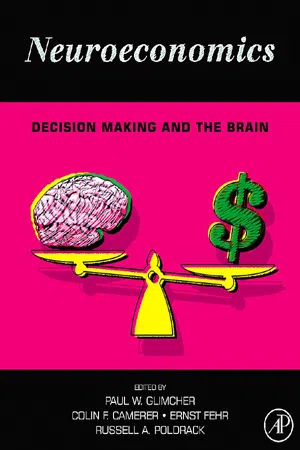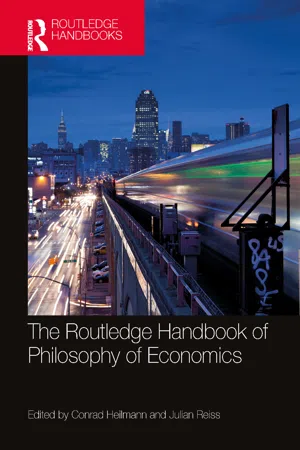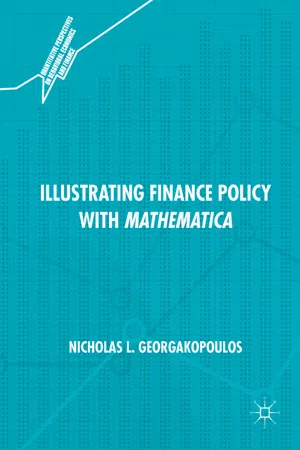Economics
Risk Preference
Risk preference refers to an individual's willingness to take on risk in exchange for potential rewards. It is a key concept in decision-making under uncertainty, as it influences choices related to investments, insurance, and other financial decisions. Risk preference can vary among individuals, with some being risk-averse, seeking to minimize risk, while others are risk-seeking, willing to take on higher levels of risk for potentially greater returns.
Written by Perlego with AI-assistance
Related key terms
Related key terms
1 of 4
Related key terms
1 of 3
6 Key excerpts on "Risk Preference"
- eBook - ePub
Neuroeconomics
Decision Making and the Brain
- Paul W. Glimcher, Ernst Fehr, Colin Camerer, Russell Alan Poldrack(Authors)
- 2008(Publication Date)
- Academic Press(Publisher)
Chapter 10 Decisions Under UncertaintyPsychological, Economic, and Neuroeconomic Explanations of Risk PreferenceElke U. Weber, Eric J. JohnsonRisk Preference: the Historical Context
Democratic and libertarian societies ask their citizens to make many decisions that involve uncertainty and risk, including important choices about pension investments, medical and long-term care insurance, or medical treatments. Risky decisions, from barely conscious ones when driving (“Should I overtake this car?”) to carefully deliberated ones about capital investments (“Do I need to adjust my portfolio weights?”) abound. As citizens have taken on more decision responsibility, unpredictability and uncertainty of decision outcomes has increased as the result of ever faster social, institutional, environmental and technological change.It is no surprise, then, that the topic of decision making under risk and uncertainty has fascinated observers of human behavior. From philosophers charged with providing tactical gambling advice to noblemen, to economists charged with predicting people's reactions to tax changes, risky choice and the selection criterion that people seek to optimize when making such decisions has been the object of theoretical and empirical investigation for centuries (Machina, 1987 ; Glimcher, 2003 ).Expected Value Theory
The maximization of expected (monetary) value (EV ) of gamble X ,(10.1)first considered in the mid-seventeenth century, was rejected as a universally applicable decision criterion based on the so-called St Petersburg paradox, where people are willing to pay only a small price (typically between $2 and $4) for the privilege of playing a game with a highly skewed payoff distribution that has infinite expected value, as shown in Figure 10.1 .Figure 10.1 Payoff distribution for St Petersburg paradox game, where a fair coin is tossed until the first “head” is scored. The payoff depends on the trial at which the first “head” occurs, with $2 if on the first trial, $4 if on the second trial, and $2n - eBook - ePub
Finance and the Behavioral Prospect
Risk, Exuberance, and Abnormal Markets
- James Ming Chen(Author)
- 2016(Publication Date)
- Palgrave Macmillan(Publisher)
Although the preceding exercise demonstrates how portfolio theory and its extensions can be harmonized with expected utility theory and its measures of risk aversion, a sense of discomfort persists. Expected utility theory’s account of risk aversion does not explain the full range of human responses to risk. 58 Although humans do tend on balance to be risk averse, risk-seeking behavior does exist. Any credible account of behavioral economics must therefore explain both risk aversion and risk-seeking. The balance of this chapter will explore the Allais paradox and the St. Petersburg paradox, two puzzles that figured prominently in the decline of expected utility theory and the willingness of economists and psychologists, whether working together or independently, to find alternative accounts of human decision-making under risk and uncertainty. 59 The difference between risk aversion and risk-seeking is readily and intuitively illustrated in graphic terms (Figs. 6.1 and 6.2). Fig. 6.1 A utility curve for a risk-averse individual Fig. 6.2 A utility curve for a risk-seeking individual Risk aversion is portrayed by a concave curve where the value of the utility function, u (x), is less than x for any value of x within the relevant range. Risk-seeking, by contrast, is depicted by a convex curve where the value of u (x) actually exceeds x. The risk premium is the difference between u (x) as the expected value of a prospect and x as its certainty equivalent. Risk-averse individuals have a negative risk premium - eBook - ePub
Models of Risk Preferences
Descriptive and Normative Challenges
- Glenn W. Harrison, Don Ross, Glenn W. Harrison, Don Ross(Authors)
- 2023(Publication Date)
- Emerald Publishing Limited(Publisher)
CHAPTER 5
THE WELFARE CONSEQUENCES OF INDIVIDUAL-LEVEL Risk Preference ESTIMATION
Brian Albert MonroeABSTRACT
Risk Preferences play a critical role in almost every facet of economic activity. Experimental economists have sought to infer the Risk Preferences of subjects from choice behavior over lotteries. To help mitigate the influence of observable, and unobservable, heterogeneity in their samples, Risk Preferences have been estimated at the level of the individual subject. Recent work has detailed the lack of statistical power in descriptively classifying individual subjects as conforming to Expected Utility Theory (EUT) or Rank Dependent Utility (RDU). I discuss the normative consequences of this lack of power and provide some suggestions to improve the accuracy of normative inferences about individual-level choice behavior.Keywords: Rank Dependent Utility; Expected Utility Theory; Risk Preferences; welfare; statistical power; model selection1 INTRODUCTION
Risk Preferences estimation is critical to evaluating models of discounting (Andersen, Harrison, Lau, & Rutström, 2014 ), subjective beliefs (Andersen, Fountain, Harrison, & Rutström, 2014 ), and other aspects of economic choice. To eliminate complications arising from both observed and unobserved heterogeneity in Risk Preferences when drawing inferences from experimental data, preferences can be estimated at the individual level. Examples of estimating these Risk Preferences at the individual level include Hey and Orme (1994 ) (HO), with the descriptive purpose of classifying subjects as conforming to one model or another, and Harrison and Ng (2016 ), with the normative purpose of calculating the expected consumer surplus (ECS) of an individual’s choices.HO elicited Risk Preferences from subjects using an instrument comprising 100 lottery pairs. For each pair, subjects were asked to select one lottery in the pair for possible payment. HO estimated 11 Risk Preference specifications and selected a “winning” model for each subject on the basis of these estimates. HN similarly collected data from subjects over 80 lottery pairs and estimated 4 Risk Preference specifications for each subject and selected a “winning” model. The primary inferential objective of HO was to determine if there was significant descriptive evidence that subjects in economic experiments regularly deviate from EUT, and found that although their EUT specification was a winning model for more subjects than any other, it did not win for a majority of subjects. On other hand, HN was primarily concerned with the normative calculation of ECS in an insurance task that their subjects also completed. The classification of individual subjects as EUT or an alternative model plays a key role in both studies.1 - eBook - ePub
Microscopic Simulation of Financial Markets
From Investor Behavior to Market Phenomena
- Haim Levy, Moshe Levy, Sorin Solomon(Authors)
- 2000(Publication Date)
- Academic Press(Publisher)
3Empirical and Experimental Evidence Regarding Preferences: Absolute and Relative Risk Aversion
3.1 INTRODUCTION
The modern economic theory of decision making under uncertainty is based on the expected utility framework developed by von-Neuman and Morgenstern (1947) . The expected utility framework makes several assumptions regarding preferences (for example, that people prefer more rather than less), and from these assumptions a decision-making rule is derived—namely, each individual can be characterized by a utility function U (W ), where W denotes wealth, such that given any uncertain situation, maximizing the individual’s welfare is aligned with maximizing the expected value of the utility function EU (W ). All the information about the preferences of an individual is given by the form of his utility function.The common functional forms that are assumed for the utility functions in the economic and financial literature include quadratic, logarithmic, power, and negative exponential utility. The negative exponential utility function U (W ) = –e–αWis an especially popular assumption because it is very convenient for analytical treatment. Quadratic utility is also an attractive modeling assumption because it allows mean-variance analysis that disregards higher moments of the return distribution. Since the microscopic simulation (MS) method is not as restricted by tractability constraints as analytical methods, one has the luxury of being able to work with any form of utility function. In this framework the choice of utility function is motivated by the realism of the preference assumed, rather than by implications for analytical tractability. Obviously, if one wishes to obtain reliable and even quantitative results from the model, one needs to be as realistic as possible in the assumptions regarding preferences.In this chapter we review empirical and experimental evidence regarding the form of individuals’ utility functions. The experimental studies, and with some qualifications the empirical studies, covered in this chapter shed light on the typical shape of subjects’ preferences as well as the degree of the risk aversion that prevails among the subjects. We employ these findings later in the MS framework. Obviously, we do not assert that all subjects have a certain preference, and heterogeneous preferences are possible. Moreover, if we find that the majority of the subjects behave according to some preference and some small proportion of the subjects behave differently (e.g., some are risk lovers), this preference composition, in principle, can be incorporated into an MS model. - Conrad Heilmann, Julian Reiss(Authors)
- 2021(Publication Date)
- Routledge(Publisher)
1 – than individuals acting alone has been deeply entrenched in economics from Smith onward. Preferences are also core to two principles of neoclassical economics – optimization and equilibrium – as well as to economics’ chief normative standard for judging institutions, policies, and outcomes – Pareto efficiency.And yet, economists also seem to care very little about preferences. Exogenous preferences are often conveniently assumed to allow for a tractable solution to what Hayek calls “the economic problem,” or the best way to allocate a given set of means.2 Furthermore, it is often claimed that economics is ultimately concerned with discovering relationships between macrovariables, rather than understanding individual decision-making.This tension is reflected in a deep disagreement over the correct interpretation of the concept of a preference. The so-called marginalists3 of the late nineteenth century, such as Jevons, Walras, and Edgeworth, grounded their marginal revolution in psychological conceptions of utility inspired by Benthamite social theory’s hedonic calculus of pleasure and pain. Moved by measurement and other concerns that cast doubt on the scientific integrity of a psychological concept of utility, later economists such as Pareto, Hicks, and Allen moved to focus on the ranking of choice alone, rather than the mental states that produce that ranking.4 However, they did not completely succeed in excising the psychological from choice modeling, and psychology has again gained prominence in economics through certain successes of behavioral economics.5This chapter addresses itself to the puzzling, seeming co-existence of psychological and nonpsychological interpretations of “preference” in economics.6 Because of the enormity and importance of the question of the correct concept of preference in economics, as well as the richness of the work addressing it, a chapter on this topic will always be hopelessly incomplete without narrowing its focus. Accordingly, I will set aside normative arguments about the concept of a preference and focus on descriptive applications of preference-based choice frameworks.7- eBook - ePub
- Nicholas L. Georgakopoulos(Author)
- 2018(Publication Date)
- Palgrave Macmillan(Publisher)
© The Author(s) 2018 Nicholas L. Georgakopoulos Illustrating Finance Policy with Mathematica Quantitative Perspectives on Behavioral Economics and Finance https://doi.org/10.1007/978-3-319-95372-4_10Begin Abstract10. Aversion to Risk
End AbstractNicholas L. Georgakopoulos1(1) Indiana University, Indianapolis, IN, USA1 Risk Aversion
Attitudes toward risk are central to the choices people make. Therefore, attitudes toward risk are important for the incentive scheme that law and policy produce as well as for the assessment of values that finance studies. In this chapter, we enter the mathematical understanding of aversion to risk when it applies to money. Attitudes toward risk outside monetary choices are still not well understood. Also, attitudes toward risk about money do not seem closely related to those about unrelated activities. We see little paradoxical about a solo ice-climber, for example, who would pay for a mistake half-way up a frozen waterfall with the ice-climber’s own life, in taking no financial risk and only investing in treasuries. Vice versa, a venture capitalist, most of whose investments are destined to fail, would not be seen as strange if the venture capitalist takes very few physical risks, driving exceedingly cautiously and exercising only in the safest ways. Aversion to physical risk has little relation to aversion to financial risk, and our economic models only deal with financial risk. From here, risk refers only to financial risk.The road to comprehending risk begins at simple gambles. Someone faces a choice between receiving a certain amount and two risky amounts. For example, the risky amounts may be $100 and $900, say, depending on the toss of a coin. If the coin comes heads, take $900, if tails then $100. The uncertainty, thus, is the $100 or $900 outcome. This example will be the foundation for understanding reactions to risk. The first step is to recognize the subjectivity of the correspondence between the risk and a certain amount.
Index pages curate the most relevant extracts from our library of academic textbooks. They’ve been created using an in-house natural language model (NLM), each adding context and meaning to key research topics.
Explore more topic indexes
Explore more topic indexes
1 of 6
Explore more topic indexes
1 of 4





